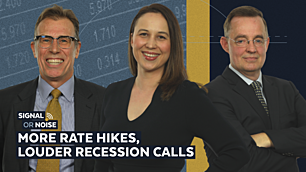"The nail in the coffin": Why the Bank of Japan's policy change matters to you
Just before Christmas, the Bank of Japan caused a rumble in trading rooms all around the globe when it handed down a small but important policy change. For six years, the world's most dovish central bank has pursued an unconventional monetary policy - part of which involved buying a mix of government-issued bonds in order to keep yields depressed.
The good news is that the policy did what it intended to do. The bad news is that it led to a worsening in financial conditions and put the world's third-largest economy out of whack with its counterparts.
At this point, I suppose you're wondering why I'd write about Japan given our economic relationship with it is far smaller than the one we share with China. But the truth is that the Bank of Japan does have a big effect on other global markets, including the US and the Eurozone. More than that, the change in policy also sparks a key question:
When the last major central bank starts the move away from accommodative policy, does this mean we're at the end of the great monetary experiment?
This wire will attempt to answer that question while providing some implications for Australian investors, with the help of Firetrail Investments' Head of Investment Strategy Anthony Doyle, and GSFM Investment Advisor Stephen Miller.
.png)
What was so unconventional?
The Bank of Japan pursued a policy called "yield curve control" (known to FinTwit and bond traders as YCC). YCC is a tactic used by central banks to buy government bonds to cap interest rates on longer-term debt. The price of bonds is inversely correlated to their yield.
It's generally used to suppress borrowing costs and stimulate the economy. In the case of Japan specifically, it was also a last-resort effort to create inflation in an economy that has been dogged by high imports and an ageing population.
"The Bank of Japan has been trying to engineer higher inflation for decades. Up until now, they had failed," Doyle said.
"There was one motivation and they invested a lot of effort into the one target without keeping an eye on the unintended consequences," Miller added.
Those unintended consequences include a surge in inflation (by Japanese standards, anyway). That's led to increased bets in financial markets that the Bank will be forced to retire this controversial policy measure by mid-year and even as soon as tomorrow afternoon's meeting.
A caveat worth noting
It's important to note tweaking this policy does not mean they have hiked rates. All they did was raise the upper band from +/-0.25% to +/-0.50%. The Japanese central bank is still buying bonds, the Yen is still heavily depreciated against the US Dollar, and their interest rate is still -0.1%.
Even if they were to move the dial again tomorrow (for example, by increasing the upper band to +/- 75 basis points), that still would not mean they have hiked rates. Even if they removed YCC completely tomorrow, it would still not mean that conventional monetary policy has returned. But, as Doyle points out, any further changes will still be cheered by investors.
"As was the case in Australia, the market is highly sceptical about the central banks’ ability to maintain YCC," Doyle said. "If the exit from YCC turbocharges yen appreciation, the move could result in spillover effects in global bond markets," Doyle said.
Miller also believes this move was enough to herald the end of something much larger.
"This was probably the final nail in the coffin because once inflation returned, it became untenable for central banks to continue with unconventional policy," Miller said. "It's unquestionably the end of unconventional monetary policy in the world ex-Japan," he added.
Yield curve control in Australia
Incidentally, we have no right to guffaw at Japan's expense on this topic. The Reserve Bank of Australia has also employed yield curve control in the recent past. In March 2020, the RBA began yield curve control when interest rates were close to zero and Governor Philip Lowe essentially shut down the idea of Australia instituting negative rates. Eventually, markets discredited Lowe's position around the lack of inflation.
"What the RBA said was conditional but they never emphasised that. And that was their mistake," Miller said. "I don't think we'll see unconventional monetary policy for a long time after this," he added.
The policy was retired in late 2021 and six months after the end, they hiked the interest rate for the first time in many years.
Miller, who's been in and around the Australian bond market for more than 40 years, argues central banks have been late in recognising the implications of free money.
But he did express one line of sympathy for Kuroda, Lowe, and others.
"Everywhere, monetary policy was being asked too much. The fiscal policy did come to the party in the end but we've forgotten how central banks can't cure demographic problems," Miller said.
What does it mean for Australian investors?
For most of the last 20 years, there's been a general understanding that bonds and equities are inversely correlated. Bar any major financial dislocations, all central banks had to do was cut rates and bond returns could offset equity returns.
Simple formula right?
Not anymore.
Miller argues that the end to unconventional monetary policy proves the importance of generating alpha in portfolios. That's not to say there is anything wrong with passive returns, but the days of the "central bank put" are gone for the foreseeable future.
"Don't think a 60/40 portfolio or any variation of this will deliver like it used to," Miller argued. "Investors need to seek out investments that don't correlate to bond beta or equity beta."
Examples of these investment ideas include:
- Inflation-linked bonds (if you think inflation has not peaked)
- Commodities (gold in Australian dollars, for instance)
- Long-short or stylised equity approaches (i.e. active management)
- Alternatives (for sophisticated investors, macro-centric hedge funds are an option)
- ...and if you can afford to keep an eye on it, currency hedging.
In contrast, Doyle believes 2023 will be a year for navigating the ramifications of central bank actions during 2022.
"We are entering a year where it is likely that we will see a peak in interest rates and easing inflationary pressures, both of which are typically good for equity markets. However, to get to that point equity markets will still have to navigate the beginning of 2023 where consumer demand is falling due to the actions of central banks," he said.
If you're worried about what all these headlines will do for your portfolio, Doyle advises having a long-term view. That's because long equity investors will have a distinct advantage because they can look through any chance of a global recession.
"The big money isn’t made in the buying and selling. It isn’t made trading in and out of the equity market. The big money is made in the waiting," Doyle said.
Stephen appeared on a recent episode of Signal or Noise, with Matthew Sherwood of Perpetual Asset Management and Diana Mousina of AMP. If you missed that episode and would like to hear more of his perspective, click here:

Never miss an insight
If you're not an existing Livewire subscriber you can sign up to get free access to investment ideas and strategies from Australia's leading investors.
I'll be in charge of asking the questions to Australia's best strategists, economists, and fixed income fund managers. If you have questions of your own, flick us an email: content@livewiremarkets.com
3 topics

